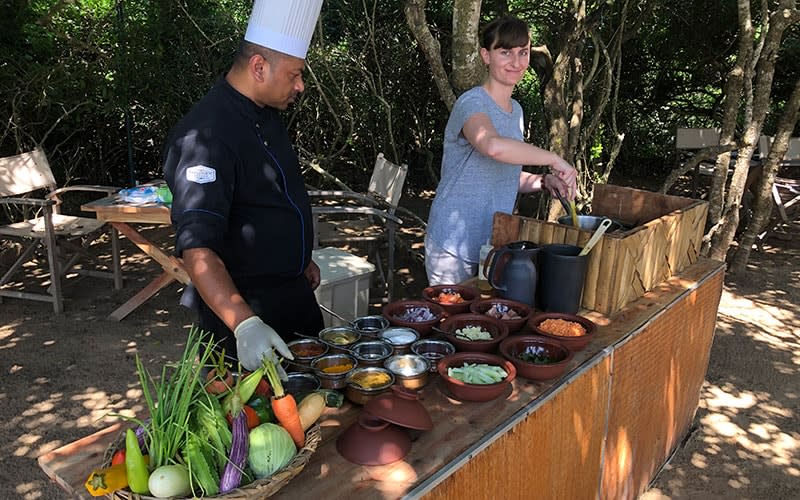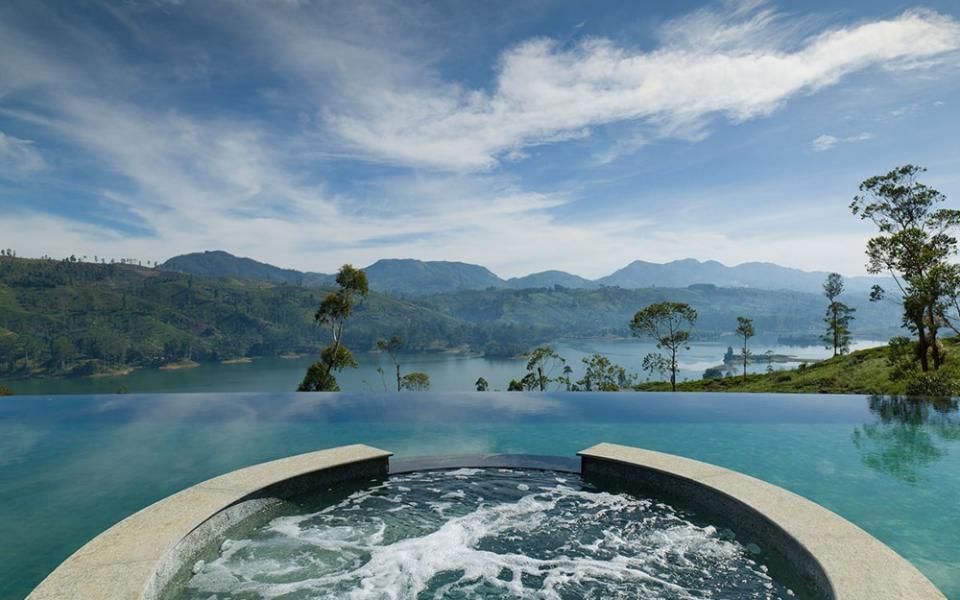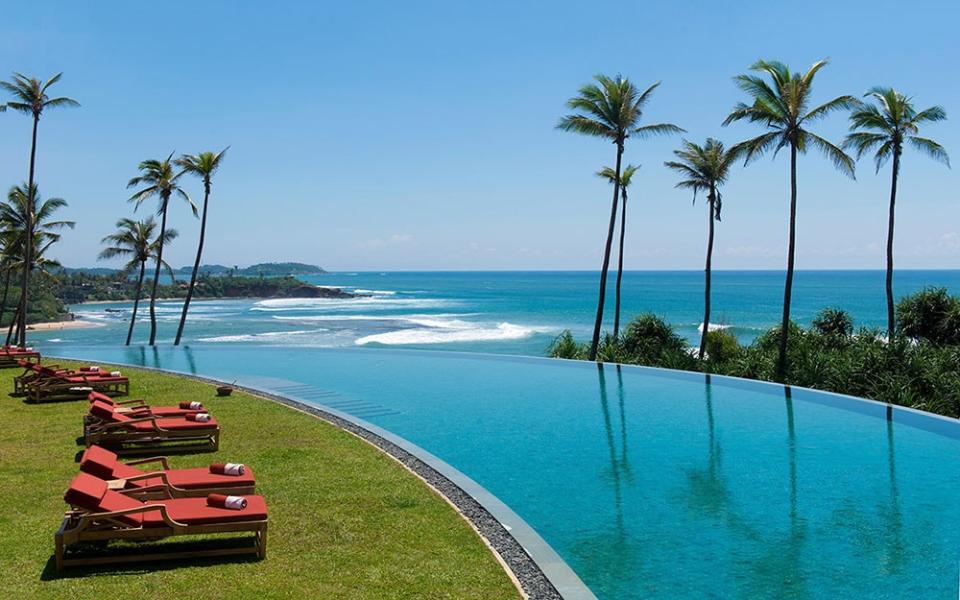Tasting in technicolour: What I learned on a foodie tour of Sri Lanka

As the pan began to bubble and beads of sweat formed on my hairline, I looked down doubtfully at the assembled ingredients bobbing around in creamy white suspension. With me at the helm, were these lentils and spices really going to turn into something resembling the rich, velvety dhals I’d been mopping up for breakfast with coconut roti the last few days?
I’m a pretty good cook, but the curries I produce in my kitchen at home are so unimpressive that I’d practically given up. So I had left behind the grey skies of London and my watery, flavourless concoctions, and flown to Sri Lanka to learn about its fresh, aromatic food and pick up some cooking tips at Wild Coast Tented Lodge in Yala National Park.

In the lodge’s outdoor kitchen, set beneath a canopy of trees offering shade from the heat of the midday sun, head chef Susantha Medagedara was teaching me how to cook my own lunch: white fish curry, cucumber curry, and of course this dhal. Under his expert instruction, the dhal reduced to smooth, golden perfection.
The cucumber curry, a traditional dish I had not yet encountered, or even heard of, turned out to be my favourite: light and fresh and bursting with the flavour of the curry leaves I was coming to love so much in the food here. Our cooking station looked like an Instagram photo shoot; an array of bright colours arranged pleasingly in separate little bowls.
Sri Lankan food is becoming ever more popular internationally; in London, Hoppers restaurant – named after the Sri Lankan bowl-shaped pancakes that are a mainstay of the national cuisine – is about to open its third outpost, while two newcomers, Kolamba and Paradise, are doing a roaring trade in Soho. The trend is not surprising, with so many people reducing meat and dairy consumption; vegetarian and vegan options (such as the dhal and cucumber curry) are plentiful in Sri Lankan food.

It’s good news for a country whose tourism is still recovering from last year’s Easter terrorist attacks, which were carried out in hotels and churches and claimed the lives of more than 250 people. They came at the height of Sri Lanka’s status as one of the world’s hottest travel destinations and saw visitor numbers plummet, but travellers have since started to return.
A visit now not only supports recovery, but offers another feel-good factor; once you are here, your carbon “foodprint” will be low. With its own cuisine to shout about, and excellent local produce, you are unlikely to see the likes of Wagyu beef or truffles on menus. Instead, expect fish caught locally and vegetables grown on site.
Wild Coast is a beachside safari camp on the south-east coast of the country, made up of 28 dreamy high-lux units (incorporating vintage-voyage-inspired details such as portholes, leather trunks and free-standing roll-top copper bathtubs) set around a free-form outdoor pool area and open-sided lounge/bar and restaurant. Days began with early-morning game drives, on which I saw elephants up close (though the elusive leopard remained so), and ended with sundowners around fire pits on the rugged beach.

Prior to Wild Coast I had stayed at its sister property, Tea Trails, set high in lush, verdant hills about five hours’ drive north along winding roads. A stay here, where rooms are spread across five bungalows, offers a completely different experience, and a window into the history of Sri Lanka’s tea trade.
On my first night, the chef prepared a tea-themed dinner. Carrot soup was subtly infused with Sencha lemongrass tea; salmon complemented by a buttery, almond tea sauce. The next day, an open-sided four-wheel-drive bumped me past the fields where women still pick tea by hand to a factory where I tasted and learned more about the different kinds of tea produced here.
Head chef Ranil Prasanna showed me around the kitchen garden that provides herbs, spices and vegetables for all five bungalows – increasingly a selling point, he explained, as organic, farm-to-table culture continues to flourish. We picked rhubarb, and he showed me how to tell which leaves were ripe and ready (by size, not colour) before making it into jam infused with Earl Grey, served at breakfast each morning alongside home-made breads and pastries.
There are some meals in life that you know, even while eating them, will remain truly unforgettable. The breakfasts at Tea Trails, set against the steep, green-blue backdrop of the hills, were just that. Coconut and rice-flour hoppers cradling fried eggs; milk rice; leek and potato curry so hot it made my bleary eyes blink; salty, grainy fish sambol which had me reaching for the fresh watermelon.

Third stop on the food trail was Cape Weligama on the south-west coast – a beach resort of 39 villas and suites with a beautiful clifftop infinity pool. This area was devastated by the 2004 tsunami, but has since become popular for surfing and blue whale watching. Although my heart sank a little when I saw the familiar avocado on toast for breakfast, there was plenty of traditional food, including kothu roti, in which the bread is finely chopped and fried with vegetables and/or meat to resemble noodles.
Sri Lankan fine dining is starting to take off in Colombo, the capital, and beyond. I joined a group sitting round an open kitchen space in Cape Weligama to enjoy a six-course tasting menu. The restaurant’s chefs take it in urns to create the menus and explain each dish while they make it. Chef Dasun Kumarage gave a gourmet bite of lobster a sense of place with chilli onion jam, cashew nuts and curry leaves.

On my last morning, chef Nissanka Alawatta took me to the small roadside market where he buys his fish. Glistening squid and octopus, huge, vivid red prawns, and fish of all shapes and sizes were laid out on wooden slats, sourced straight off the boats or from “stilt” fishermen, unique to Sri Lanka, who perch across wooden poles in the sea to catch their wares, balanced expertly above the waves as the sun rises and sets each day.
I chose some squid and, back at the hotel, Nissanka grilled and combined it with tangy orange and grapefruit, fresh fennel and leaves to make me an intense yet delicate final lunch. As I ate, I thought about the fishmongers on my local high street and how infrequently I visited them. Having stocked up with spices and gathered recipes to take home with me, I vowed that when I recreated the white fish curry I’d made at Wild Coast, I would make the effort to shop independent. In Sri Lanka, I’d learned that the key ingredient to everything I’d eaten wasn’t necessarily time, but thought: concentrating on what I was doing, rather than listening to podcasts or talking on the phone, as I often did when cooking at home.
Back in London, I found that the typed-out recipes, lacking the detail of cookbooks, forced me to focus, to cast my mind back and recall the instructions I’d originally been given beneath that tropical canopy of shade. My dhal is still a work in progress (slightly too thick) but, along with the cucumber curry, has managed to bring a little Sri Lankan sunshine to the depths of a British winter.
Scott Dunn offers a seven-day trip from £3,100 per person, based on two people travelling in high season 2020. The price includes two nights each at Tea Trails, Wild Coast Tented Lodge (both full-board) and Cape Weligama (with breakfast), return flights with Sri Lankan Airlines and private transfers. A tea-infused dinner, tea factory tour and one daily game drive are also included. Cookery class, $50 (£39); market visits, $90; chef’s table dining experience, $100.


